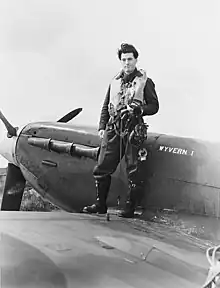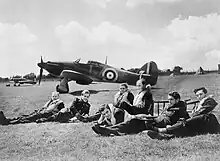Alan Eckford
Alan Francis Eckford, DFC (6 February 1919 – 6 December 1990) was a British flying ace of the Royal Air Force (RAF) during the Second World War. He was credited with at least eight aerial victories.
Alan Eckford | |
|---|---|
 Eckford and his Spitfire, 1942 | |
| Born | 6 February 1919 Thame Park, Oxfordshire, England |
| Died | 6 December 1990 (aged 71) Rickinghall, Suffolk, England |
| Allegiance | United Kingdom |
| Service/ | Royal Air Force |
| Rank | Squadron Leader |
| Unit | No. 32 Squadron No. 242 Squadron No. 253 Squadron No. 154 Squadron |
| Commands held | No. 242 Squadron |
| Battles/wars | Second World War
|
| Awards | Distinguished Flying Cross |
Born in Thame Park, Eckford joined the RAF in late 1938. In the early stages of the Second World War he served with No. 32 Squadron, including a brief period in France following the German invasion of the Low Countries. During the later stages of the Battle of France, he flew with No. 242 Squadron as a reinforcement pilot. During the subsequent Battle of Britain, he returned to No. 32 Squadron and was heavily engaged in the fighting over Kent during July and August, achieving several aerial victories. In the final weeks of the aerial fighting over Britain, he flew with No. 253 Squadron. He remained with the unit until late 1941, when he was rested from operational flying. After a period of instructing duties, he returned to active operations in mid-1942, serving with No. 154 Squadron on the Channel Front, including during the Dieppe Raid, and in North Africa. He commanded No. 242 Squadron during the final stages of the North African campaign before returning to the United Kingdom. He served in the Air Ministry for the remainder of the war. He died in 1990, aged 71. A photograph taken of Eckford and other pilots of No. 32 Squadron during the Battle of Britain inspired the ‘Spirit of The Few’ Monument at Hawkinge.
Early life
Alan Francis Eckford was born on 6 February 1919 in Thame Park, Oxfordshire, in England. He went to King Edward VI Grammar School in Birmingham before going on to Loughborough College on an engineering scholarship. Eckford joined the Royal Air Force (RAF) in November 1938 on a short service commission. Once his flight training was completed, he was posted to No. 32 Squadron as a pilot officer.[1][2] At the time, the squadron was based at Biggin Hill and operated Hawker Hurricane fighters.[3]
Second World War
Following the outbreak of the Second World War, No. 32 Squadron was scrambled several times to deal with incoming German aircraft, but were mostly unsuccessful. On 18 May 1940, the squadron was sent to France as reinforcements for the RAF fighter squadrons already there. It was based at Abbeville and was immediately thrown into the aerial fighting.[3] Eckford destroyed a Messerschmitt Bf 109 fighter over Cambrai the day after arriving in France.[4] The squadron returned to Biggin Hill a few days later and was engaged in patrolling over Kent until the end of the month.[1]
Eckford returned to France in early June as a reinforcement pilot for No. 242 Squadron, which was based at Châteaudun at the time and provided cover for the British forces retreating to the Atlantic coast. It was heavily engaged and had suffered heavy casualties. Eckford flew several sorties before the squadron moved to Le Mans. Flying from an airfield there, he shot down a Bf 109 on 14 June in the Seine-Rouen region. Patrolling continued in the area around the western Bay of Biscay until 18 June, at which time No. 242 Squadron was withdrawn to England.[1][5]
Battle of Britain

Now under the command of Squadron Leader Douglas Bader and based at Coltishall, No. 242 Squadron was brought back up to strength and resumed operations on 9 July.[5] Eckford intercepted and damaged a Heinkel He 111 medium bomber off Yarmouth the next day.[4][6] He was posted back to No. 32 Squadron, flying from Biggin Hill, towards the end of the month.[2] By this time, the Battle of Britain was well underway, and Eckford and the other pilots of the squadron flew several sorties daily to intercept incoming Luftwaffe bomber raids. On 18 August he destroyed a Junkers Ju 88 and a Dornier Do 17, both bombers and the latter attacking the airfield at Kenley, on separate sorties. He damaged a He 111 on 26 August.[7]
Promoted to flying officer in early September,[2] Eckford was transferred to No. 253 Squadron later that month.[7] The squadron operated Hurricanes from Kenley and faced heavy attacks by the Luftwaffe.[8] He destroyed a Messerschmitt Bf 110 heavy fighter over Maidstone on 27 September. Regular patrolling continued into October, including one at night over London, and he shot down a Bf 109 over Kent on the last day of the month.[4][9]
Although the Battle of Britain was largely over by November, Eckford was still heavily engaged in patrols, shooting down a Bf 109 near Dungeness on 5 November. He shared in the destruction of a Do 17, and damaged another, on 22 November near Newhaven. The following day, while flying to the west of Cap Gris-Nez, he destroyed a Bf 109. On another sortie the same day, he claimed a second Bf 109 as probably destroyed.[4][9]
No. 253 Squadron was briefly rested at the end of November but was brought back into service in early December, mainly on patrols with many being uneventful.[8][9] Later in the month, Eckford's award of a Distinguished Flying Cross was announced. The citation, published in The London Gazette, read:
This officer has displayed great keenness in his attacks against the enemy both in France and in England. His courage and skill, often in the face of odds, have enabled him to destroy six enemy aircraft.
— The London Gazette, No. 35022, 24 December 1940.[10]
Channel Front
In early 1941, No. 253 Squadron moved north and, operating from Skeabrae, carried out convoy patrols over the North Sea for the next several months. As well as these patrols, Eckford, now a flight commander, carried out several sorties at night. In November he was taken off operations and posted to No. 55 Operational Training Unit at Usworth in Sunderland.[8][9]
Eckford, now holding the rank of flight lieutenant, returned to operations in May 1942 with No. 64 Squadron. His new unit operated Supermarine Spitfire fighters from Hornchurch on sweeps over France. He flew with the squadron for two months and was then transferred to No. 154 Squadron.[11] This unit, another Spitfire squadron, was part of the Hornchurch fighter wing and at the time of Eckford's posting was engaged in sweeps to France and convoy patrols over shipping in the Thames Estuary.[12] It participated in the Dieppe Raid as cover for the landings of 19 August, during which Eckford engaged and damaged two German aircraft, a Dornier Do 217 bomber and a Focke Wulf Fw 190 fighter. On 27 August, while carrying out a search for a pilot downed in the English Channel, he encountered and probably destroyed a Fw 190 5 miles (8.0 km) south of Dover.[4][11]
Subsequent war service
A month after the Dieppe Raid, No. 154 Squadron was transferred to North Africa, becoming operational from Djidjelli airfield, in Algeria, in November. From there it provided aerial support for the ground troops engaged in Operation Torch and also protected the shipping in Algiers harbour.[12] On 12 November, Eckford combined with Group Captain Petrus Hugo to shoot down a Ju 88 in the area over Djidjelli. The following day, Eckford destroyed another Ju 88 in the same vicinity, having already been credited with a third-share in a second Ju 88 destroyed. His Spitfire was damaged in the engagement and he crash-landed without injury on the airfield. He was wounded in December during a Luftwaffe attack on Djidjelli airfield.[4][13]
By early 1943, Eckford had recovered from his wounds and returned to operations, which by that time mainly involved patrols over Allied shipping in the area.[12][13] In March, Eckford took command of his former unit, No. 242 Squadron, also based in Algeria and carrying out escort missions for heavy bombers. Once the North African campaign concluded, the squadron was moved to Malta to prepare for the forthcoming Allied invasion of Sicily.[5] At this time Eckford was transferred back to the United Kingdom to take up a posting at the Air Ministry. He was promoted to squadron leader on 1 July 1944 but remained at the Air Ministry for the rest of the war.[2][13]
Eckford was discharged from the RAF in February 1946.[13] He is credited with eight or nine enemy aircraft destroyed, two or three probably destroyed, and five damaged. The uncertainty in the number of his aerial victories is due to the Bf 109 that was destroyed on 5 November 1940; in his logbook, this is described as being destroyed while in Fighter Command's 'Combats and Casualties', it is recorded as being probably destroyed.[4]
Later life
Little is known of Eckford's civilian life after his military service. He died at Rickinghall, in Suffolk, on 6 December 1990.[14]
In September 2002 his medals, which in addition to the DFC including the 1939-45 Star with Battle of Britain clasp, Air Crew Europe Star with France and Germany clasp, Africa Star with North Africa 1942-43 clasp, and the Defence and War Medals, came up for auction, fetching £15,000.[15] The medals are presently owned by Lord Michael Ashcroft.[16]
Eckford is remembered in a memorial, the ‘Spirit of The Few’ Monument, unveiled on 29 July 2022 at Hawkinge airfield.[17] He is represented as one of seven bronze sculptures of pilots of No. 32 Squadron, replicating a photograph taken of the men during the Battle of Britain.[17]
Notes
- Ashcroft 2012, p. 105.
- Wynn 1989, p. 123.
- Rawlings 1976, pp. 88–89.
- Shores & Williams 1994, p. 245.
- Rawlings 1976, pp. 342–344.
- Ashcroft 2012, p. 106.
- Ashcroft 2012, pp. 106–107.
- Rawlings 1976, pp. 357–358.
- Ashcroft 2012, pp. 108–109.
- "No. 35022". The London Gazette. 24 December 1940. p. 7213.
- Ashcroft 2012, p. 110.
- Rawlings 1976, pp. 294–295.
- Ashcroft 2012, p. 111.
- "The Airmen's Stories - F/O A F Eckford". Battle of Britain London Monument. Retrieved 1 December 2022.
- "Lot 1424". Dix Noonan Webb. Retrieved 1 December 2022.
- Ashcroft 2012, pp. xv–xvi.
- "'Spirit of The Few' Monument unveiling". RAF News. 3 August 2022. Archived from the original on 1 December 2022. Retrieved 1 December 2022.
References
- Ashcroft, Michael (2012). Heroes of the Skies: Amazing True Stories of Courage in the Air. London: Headline Publishing. ISBN 978-0-7553-6389-6.
- Rawlings, John (1976). Fighter Squadrons of the RAF and Their Aircraft. London: MacDonald & James. ISBN 0-354-01028-X.
- Shores, Christopher; Williams, Clive (1994). Aces High: A Tribute to the Most Notable Fighter Pilots of the British and Commonwealth Forces in WWII. London: Grub Street. ISBN 1-898697-00-0.
- Wynn, Kenneth G. (1989). Men of the Battle of Britain. Norwich: Gliddon Books. ISBN 0-947893-15-6.